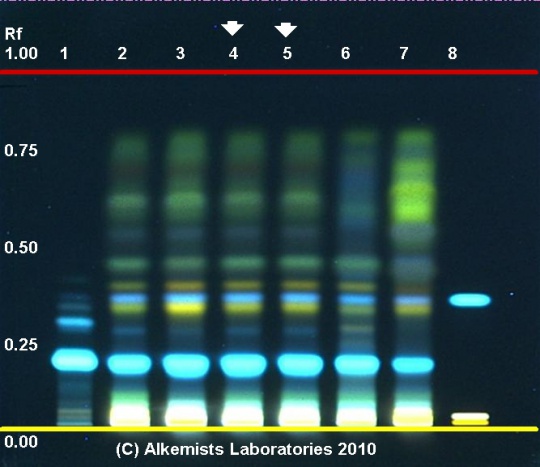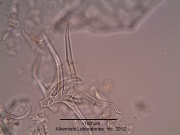Revision as of 23:53, 22 October 2012 by
JKim (Talk)
Introduction
Macroscopic Entries
Microscopic Entries
| Branched covering trichomes from the lower surface of the leaf observed at 400x with Acidified Chloral Hydrate Glycerol Solution.cellular structures identified in this botanical specimen are branched covering trichome from the lower surface of the leaf and the large glandular scales) when observed at 400x with Acidified Chloral Hydrate Glycerol Solution.
Source: Elan M. Sudberg, Alkemist Laboratories [1]
|
|
|
|
HPTLC Entries

Rosmarinus officinalis HPTLC ID - Natural Product Reagent + PEG UV 365 nm
Rosemary (leaf) (Rosmarinus officinalis)
Lane Assignments Lanes, from left to right (Track, Volume, Sample):
- 3 μL Rosmarinic Acid ~0.1% in CH3OH
- 3 μL Rosmarinus officinalis-1 (leaf)
- 3 μL Rosmarinus officinalis-2 (leaf)
- 3 μL Rosmarinus officinalis-3 (leaf)
- 3 μL Rosmarinus officinalis-3 (leaf)
- 3 μL Rosmarinus officinalis-4 (leaf)
- 3 μL Rosmarinus officinalis-5 Vouchered Specimen (herb)
- 1 μL Caffeic acid, Chlorogenic Acid, Hyperoside, Rutin ~0.1% in CH3OH
Reference materials used here have been authenticated by macroscopic, microscopic &/or TLC studies according to the reference source cited below held at Alkemists Laboratories, Costa Mesa, CA.
Stationary Phase Silica gel 60, F254, 10 x 10 cm HPTLC plates
Mobile Phase toluene: ethyl formate: HCOOH [5/4/1]
Sample Preparation Method 0.3g+3mL 80% CH3OH sonicate/heat @ 50°C ~ 1/2 hr
Detection Method Natural Product Reagent + PEG -> UV 365 nm
Reference see British Pharmacopoeia, 2003
Source: Elan M. Sudberg, Alkemist Laboratories [2]
|
Other Points of Interest
Cite error: <ref> tags exist, but no <references/> tag was found


